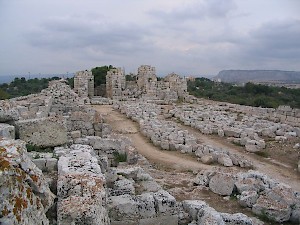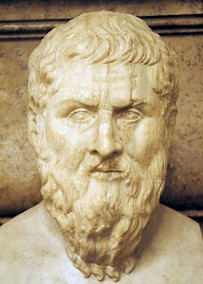History of Syracuse (3)
Q1954223Syracuse: the ancient capital of Sicily.
Dionysius I and Dionysius II

Dionysius became tyrant of Syracuse in the crisis year 405, improving his position by marrying to a daughter of Hermocrates. In the proceeding years, the Carthaginian general Hannibal had greatly expanded Carthaginian power on Sicily after capturing Selinus, Himera, and Acragas. Now, their commander Himilco was besieging Gela, and Dionysius proceeded against him. Only to be defeated. His soldiers would have killed him if he had not been protected by his mercenaries. Only Camarina, Leontini, Syracuse and the northeastern part of Sicily were still unoccupied by the Carthaginians, but the Greeks were miraculously saved when a plague ravished Himilco's army. Both sides were happy to sign a peace treaty, which left Carthage in direct control of the western part of the island, where it ordered the newly conquered cities to pay tribute.
Yet, Dionysius had survived and his mercenaries helped him stay in the saddle. He occupied Ortygia (the "old city" of Syracuse) and built a citadel. Indeed, it seemed as if Syracuse had been occupied after all - although not by the Carthaginians but by its own tyrant. The Syracusans hated him and revolted as early as 404 (Dionysius' wife was raped and committed suicide), but Dionysius was able to divide his opponents by redistributing the land, liberating slaves, and helping the urban poor. These "new citizens" were among his most loyal supporters. Dionysius' coup had been a social revolution as well.

If Dionysius wanted to win the hearts of the Syracusans, he had to wage war against powerful Carthage again. As a preparation, he conquered two native towns and intimidated Leontini into surrender. Traitors helped him gain control of Catane and Naxos. Diplomatic moves gave him access to Messana, west of the Strait, and a grain shipment to Rome gave him some goodwill in Central Italy. Again, conquered people were resettled - Syracuse now had 60,000 inhabitants and expanded to the Neapolis - and a new city wall was built, larger than any ancient city had. A new market was built. In the west, a fort named Euryalus was constructed. It was designed for the use of catapults, a new weapon that had recently been developed by Dionysius' engineers.
In 398, the tyrant declared the war he had been preparing for, and immediately marched to the far west, where he was, in spite of daring counterattacks by the Carthaginian commander Himilco, able to capture Motya. It was a splendid victory, and the first military operation in world history that relied heavily upon artillery.
Next year, however, Himilco returned. He recaptured Motya and proceeded to the east, where the native population joined him. In the winter of 397/396, he laid siege to Syracuse, which received support from Sparta. Again, a deadly plague in the Carthaginian army saved the city of Dionysius, who attacked the Carthaginians and expelled them. This was not the end of the war, which lasted until 392, but both sides were now exhausted. In the peace treaty, the Carthaginians accepted that the towns in central Sicily, which had paid tribute, were to remain independent. With some justification, Dionysius could claim that he had liberated them - and soon, they were his subjects.
In the next years, he expanded his power, conquering Rhegium in the "toe" of Italy in 387, which gave the Syracusans full control of the Strait. An inscription in Athens calls Dionysius the "chief of Sicily", which is not far beside the point. He controled four fifth of the great island.
By now Dionysius had started to believe in his own invincibility and attacked Carthage again, but the only result of the war of 383-378 was that he had to pay a large indemnity, and that his allies in the west lost territory. The frontier between Carthaginian and Greek territory was to be at the river Halycus. On the other hand, the Carthaginian ally Croton in southern Italy was added to Dionysius' empire. At the end of his life, he launched a new ware against Carthage (368), but next year, he died and his son and successor Dionysius II concluded a new peace treaty. Neither side had gained anything.
Dionysius II was a more moderate man, interested in philosophy and aware of the fact that Fortune could take way her blessings just as easy as she had given them - something that is shown by the famous story about his courtier Damocles. In fact, the younger Dionysius is a tragic figure who understood that he would only be safe if he won the hearts of this subjects, but he was clumsy in obtaining popularity. For example, he allowed the resettled people of several towns to return home, but they continued to hate the Syracusan leader anyhow.

Among Dionysius' advisers was his uncle Dion, who invited his friend, the Athenian philosopher Plato, to come to Syracuse and help him direct the tyrant. The results were disastrous, because the courtiers feared Dion's influence and accused him of high treason, for which they could indeed produce some (fake?) evidence. Dion was sent into exile and the philosopher was requested to offer his advise elsewhere.
However, in 361, Dionysius invited Plato again, and he answered the call. This time, he stayed several years and learned more about Sicilian politics than during his first visit. His discovered that his pupil Speusippus had advised Dion to obtain the right to return with force now that philosophy had failed. Dion agreed and started to raise an army. Plato knew about it but did nothing to prevent war. In the summer of 357, Dion landed at Heraclea Minoa in the Carthaginian part of Sicily, marched to the west, collected supporters in the Greek towns along his way, and captured Syracuse, except for the citadel, which was still occupied by adherents of Dionysius.
Dion was hailed as a liberator when he promised that he would not rule as a tyrant. Yet, he was not quite the statesman Plato believed him to be. The new ruler preferred an oligarchy and disappointed his democratic fellow-citizens. He was also unable to protect the city against the raids of Dionysius' mercenaries, and it took some time before Dion was master of Ortygia and the citadel. He did not enjoy his victory for a long time, because he was assassinated by agents of the Platonic philosopher Callippus (354), who was able to control the Syracusan democracy for two years but was killed. The next five years saw new leaders (Hipparinus and Nysaeus) but in 347, Dionysius returned.
This was not the end of the civil war. Dionysius, predictably embittered, had changed into a cruel despot, and the Syracusans invoked help from a man named Hicetas, who was able to liberate the city. In order to force Dionysius away from Ortygia, he invited the Corinthians to offer help, and brought in the Carthaginians, who sailed into the harbor of Syracuse.
At the same time, the other cities in the realm of Dionysius saw regime change, and the end of organized government. The native tribes of Sicily and Italy, which had been kept away from the Greek cities by Dionysius I and Dionysius II, reorganized themselves and descended to the coastal plains.
The collapse of Greek power was now complete. It is easy to see the deepest cause: one-man rule and the consequent corruption of citizenship. Political life had been disturbed, foreign mercenaries kept the tyrants on the throne as if he were an occupier, and people were unwilling and unable to accept political responsibility. There were few countries in the Greek world that were less suited for Plato's philosophical-political experiment.